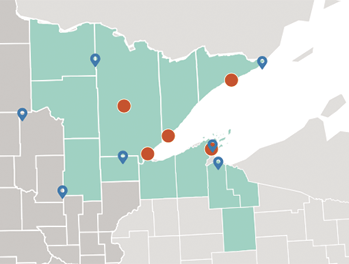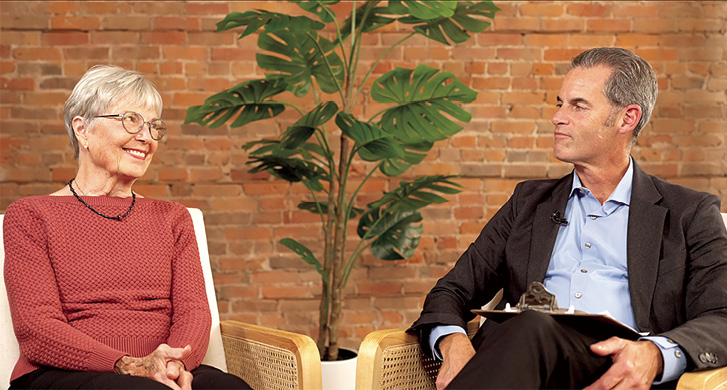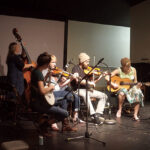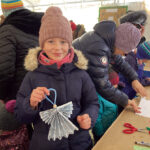In the world of Monopoly, a popular board game, players occasionally find themselves landing on the Community Chest square. It’s a windfall for the individual, but it comes with a catch; it swiftly empties the Community Chest, requiring several turns to amass those communal riches once more.
In the real world, many nonprofit organizations operate in similar fashion. They conduct fundraisers, launch capital campaigns, host galas, raffles, and car washes or bake sales to collect funds. Once the money is raised, it’s put to good use. And it is spent.
Shaun Floerke, the president and CEO of the Duluth Superior Area Community Foundation (DSACF), presides over DSACF from spacious quarters on the 7th floor of Duluth’s Medical Arts Building. The Foundation is able to give grants and scholarships by investing it’s money and spending the interest of dividends only. Since 1983 they have distributed more than $63 million through more than 450 funds.
Floerke and the entire community recently celebrated an event at the Clyde Iron Works in Duluth. Why the jubilation? Establishing a community foundation in Duluth and the Arrowhead region during the challenging economic climate of the early 1980s and maintaining its financial viability for four decades is no small feat. Nov. 2 marked the 40th anniversary of the Community Opportunity Foundation. Some 4,790 individuals have donated to that fund. Floerke said, “We’ve had gifts from $1 to $1 million.”
Floerke Sound Familiar?
If Floerke’s name sounds familiar, it might be because he served as a judge in Minnesota’s Sixth Judicial District from 2004 until he joined DSACF in January 2021. As a judge, he often encountered people at the end of their journeys, typically when they faced legal troubles. In his new role, he aspires to help people further “upstream,” offering opportunities before they find themselves in legal, social, or personal difficulties.

Floerke pointed out that many people are unaware of the Foundation. Its origins can be traced back to the challenging economic landscape of the early 1980s. The Foundation is committed to place-based funding, directing all its resources toward nonprofits and scholarships.
Floerke swiftly transitioned to the various other programs the Foundation supports, including scholarships, grants for food access, youth development, the arts, historical programs, and various other nonprofit initiatives.
He stressed the significance of individuals considering the Foundation in their wills. He cited individuals and couples who have come into their elder years with lots of money and either have no children or their children are doing well, so they want to leave a legacy to help others in their community. Financial planners and/or attorneys can often help them with this.
One noteworthy aspect of the Foundation’s approach is its commitment to minimizing bureaucratic obstacles for grantees. They aim to streamline the grant application process and reporting requirements.
Moira Villiard, an Indigenous artist known for her collaborative murals and exhibitions, joined the board to gain insights into foundation operations. She said, “I want to support folks who might never access this Foundation.” She echoed the need to streamline the application process. Previously, as an artist applying for grants, she found the Foundation’s outdated internet portal cumbersome, but it has since been updated, which is expected to improve the application process.
It’s Not Just Duluth and Superior
Don’t let the name “Duluth Superior Area” mislead you; as Floerke said, “There’s a lot in those four little letters.” The Foundation’s reach extends to Carlton, Aitkin, Cook, and Lake Counties, as well as communities in Wisconsin’s Ashland, Douglas, Bayfield, Iron, and Price Counties and has four affiliates: Eveleth Foundation, Two Harbors Area, Cook County, and Apostle Islands Chequamegon Bay. Each affiliate has its committee for outreach and grants, often benefiting those communities.

How It All Began
In the early 1980s, Duluth faced challenging economic conditions, prompting an exodus of its residents. Some might recall a billboard at the time bearing the message, “Will the last one leaving Duluth, please shut off the lights.” However, amid this uncertainty, a visionary named Kay Slack, who served as the board president of United Way between 1981 and 1982, emerged.
Slack, now 90, reflected on that period. “It was really tough going with fundraising that year and meeting our goals.” She said, “It was kind of desperate. But I realized that other cities and towns, big and small and with community foundations, had a fallback. They could fill in the voids in hard times. So that thought kind of germinated.”
In 1982, Slack, alongside Jay Hess, then-head of United Way, embarked on a mission to garner support for their foundation idea. As Slack recalled, their initial inquiries yielded a common refrain: “Oh, we tried it twice before, and it didn’t work.”
Undeterred, they sought guidance beyond Duluth. Slack said, “We interviewed foundation chairs and presidents down there (the Twin Cities) and found great support in the Bush Foundation. We told them about the negative references we were getting here, and they said, ‘Just do it. It’ll work.’”
Richard Burns meticulously drafted all the Foundation’s bylaws and handled the paperwork, adhering to the many tax-related rules and regulations that govern community foundations. The Blandin Foundation pledged a $25,000 grant, contingent on the completion of a feasibility study and matching funds. Slack and Bev Goldfine believed they could raise the necessary $25,000. Monte Goldfine, in their search for a solution, proposed a straightforward idea: “You just go to five people and ask them for $5,000.” While it was a substantial sum in the early ‘80s, their determination prevailed.
Today, Fred Friedman, retired public defender for northeast Minnesota, serves on the board. He said he serves, “Because their goals are absolutely correct in being inclusive. Too many (foundations or nonprofits) are geo-centric to their neighborhood. This is for everyone.”
In essence, the DSACF has not only been playing the philanthropy game, but adding a twist worthy of the most strategic Monopoly master. In their world, the money multiplies, ensuring that giving back to the community remains a perpetual journey of growth, hope, and enduring impact. For four decades, nonprofits and students have reaped the benefits of this innovative approach, with millions of dollars in grants and scholarships making a substantial difference.




